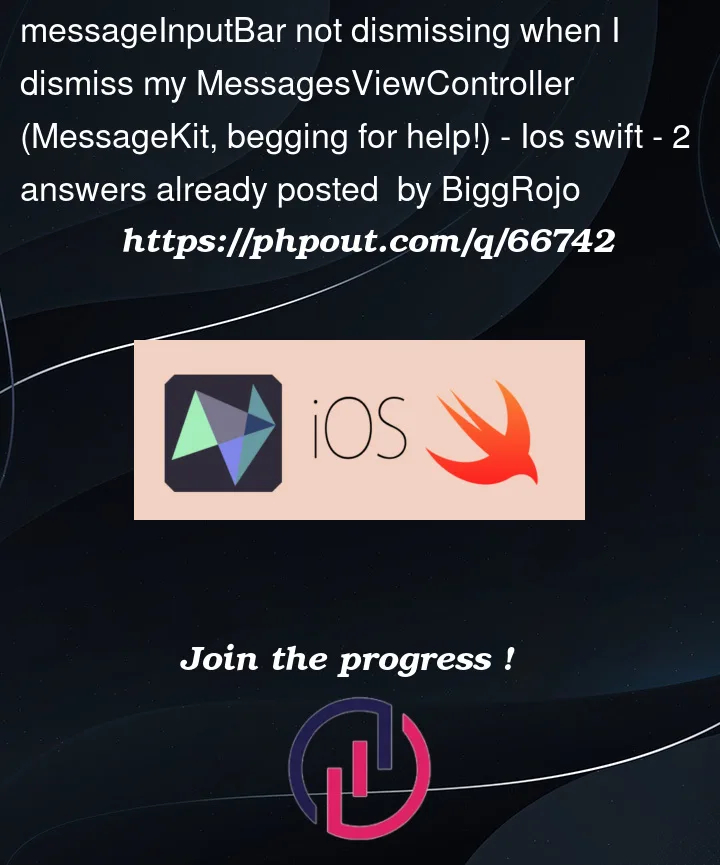I am using MessageKit. I’ve created a MessagesViewController. I add messageInputBar as a subview from viewDidLoad along with a navigational bar that includes a back button. Whenever I am in this view controller and I tap on the messageInputBar’s text field and then tap the back button, the messageInputBar stays on the screen when the app goes back to the previous UIViewController. If I don’t tap on the messageInputBar when i first enter the MessagesViewController and press the back button, the messageInputBar properly is dismissed. Below is my code
override func viewDidLoad() {
super.viewDidLoad()
setUpNavBar()
navigationItem.largeTitleDisplayMode = .never
maintainPositionOnKeyboardFrameChanged = true
scrollsToLastItemOnKeyboardBeginsEditing = true
messageInputBar.inputTextView.tintColor = .systemBlue
messageInputBar.sendButton.setTitleColor(.systemTeal, for: .normal)
messageInputBar.delegate = self
messagesCollectionView.messagesDataSource = self
messagesCollectionView.messagesLayoutDelegate = self
messagesCollectionView.messagesDisplayDelegate = self
loadChat()
self.view.addSubview(messageInputBar)
messageInputBar.translatesAutoresizingMaskIntoConstraints = false
NSLayoutConstraint.activate([
messageInputBar.bottomAnchor.constraint(equalTo: self.view.bottomAnchor),
messageInputBar.widthAnchor.constraint(equalToConstant: self.view.bounds.width)
])
NSLayoutConstraint.activate([
messagesCollectionView.topAnchor.constraint(equalTo: self.view.topAnchor, constant: 100)
])
}
func setUpNavBar() {
let navBar = UINavigationBar()
self.view.addSubview(navBar)
navBar.items?.append(UINavigationItem(title: (selectedUser?.userFirstName)!))
let backButton = UIBarButtonItem(title: "Back", style: .plain, target: self, action: #selector(backButtonTapped))
navBar.topItem?.leftBarButtonItem = backButton
navBar.translatesAutoresizingMaskIntoConstraints = false
NSLayoutConstraint.activate([
navBar.topAnchor.constraint(equalTo: self.view.safeAreaLayoutGuide.topAnchor),
navBar.heightAnchor.constraint(equalToConstant: 44),
navBar.widthAnchor.constraint(equalToConstant: self.view.bounds.width)
])
}
@IBAction func backButtonTapped(_ sender: Any) {
let transition = CATransition()
self.view.window!.layer.add(transition.segueLeftToRight(), forKey: kCATransition)
self.dismiss(animated: false)
}




2
Answers
I installed MessageKit using Cocoapods later to find out they dropped support for Cocoapods. So I completely migrated my entire project over to Swift Package Manager to get the latest MessageKit which includes the setup for the inputbar in their code. No idea why they would release a version that didn't have this initially? Anyways, solved my problem!
As you have created
MessagesViewController, you don’t need to explicitly addmessageInputBarto the bottom of the view.Let’s look at the source of MessageKit
The following code section should be removed from your source as the
messageInputBarhas already been set up in the library.Now, your scenario
Whenever, there is an object that you interact with (eg.
messageInputBar), and it is not deallocated (stays in view) after you dismissed the view controller, there is amemory leak.If you repeatedly enter and dismiss the view controller, you will observe a rise in the memory usage of the app. So, finding out which object is creating this
retain cycle, should solve this issue.